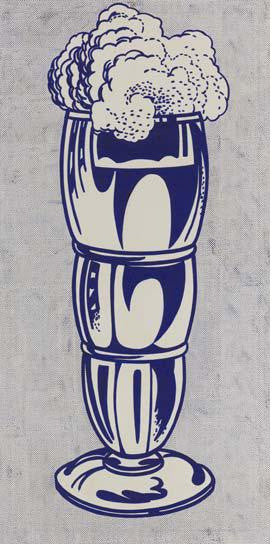Two icons of the Pop Art movement will be found on the front and back covers of the catalogue for Sotheby's Contemporary Art Evening Auction next month: Andy Warhol's Coca-Cola [4] Large Coca-Cola (estimated at $20/25 million) and Roy Lichtenstein's Ice Cream Soda (listed at $12/18 million).
Both works date to 1962, a watershed year that heralded the beginning of Pop art, and illustrate the essential role that popular culture and consumerism in post-World War II America played in the movement, evidenced by the selection of soda pop as the subject matter in each case.
Both monumental masterworks were included in key, early exhibitions of Pop art in 1963 and neither has appeared on the market in several decades. They will be shown at Sotheby's in Hong Kong and London before returning to New York for exhibition and sale.
"Many factors resulted in the advent of Pop art, including a movement away from the abstract expressionist idiom to the clarity of a single, high-impact image, and in these two paintings, both individually and as a couple, it all comes together," commented Tobias Meyer, Worldwide Head of Contemporary Art.
"The synchronicity is remarkable; it's almost as if they were painted in the same studio, but of course, they weren't."
Andy Warhol's iconic masterpiece, Coca-Cola [4] Large Coca-Cola, is the last of four paintings of individual Coca-Cola bottles executed by Warhol in 1961 and 1962, and the largest of the group, scaled at 81 5/8 x 56 7/8 inches.
Warhol was fascinated by the Coca-Cola bottle and it was a perfect subject for him - an ordinary, mass produced object, yet loaded with the provocative symbolism of Capitalist America:
"What's grand about this country is that America started the tradition where the richest consumers buy essentially the same thing as the poorest…you can know that the President drinks Coke, Liz Taylor drinks Coke, and, just think, you can drink Coke too. A Coke is a Coke and no amount of money can get you a better Coke."
Andy Warhol, The Philosophy of Andy Warhol, New York, 1975, pp. 100-101
Coca-Cola [4] Large Coca-Cola is the only work from the series that Warhol chose to show publicly in the 1960s, and the reason for that decision can be found in his own diaries - POPism: The Warhol '60s.
In it, Warhol recounts a visit he received from the director and art critic Emile de Antonio during which he showed his guest two paintings he had recently completed:
"One of them was a Coke bottle with Abstract Expressionist hash marks halfway up the side. The second one was just a stark, outlined Coke bottle in black and white. I didn't say a thing to De.
I didn't have to - he knew what I wanted to know. 'Well, look, Andy,' he said after staring at them for a couple of minutes. 'One of these is a piece of shit, simply a little bit of everything. The other is remarkable - it's our society, it's who we are, it's absolutely beautiful and naked, and you ought to destroy the first one and show the other.'"
![Andy Warhol's Coca-Cola [4]Large Coca-Cola](https://cdn.shopify.com/s/files/1/1645/0221/files/Warhol-Cola.jpg) Andy Warhol's Coca-Cola [4] Large Coca-Cola |
Coca-Cola [4] Large Coca-Cola is a perfect example of the artist's homage to advertising, highlighting the relationship between big business and the public through an enlarged icon of consumerism.
Soon after its execution, Coca-Cola [4] Large Coca-Cola was acquired by the noted collectors Mr. and Mrs. Melvin Hirsh, and included in one of the first exhibitions on Pop art - Pop Art USA - at the Oakland Art Museum in September 1963. It was then sold at auction in 1983, when it was acquired by the current owner.
Also executed in 1962, Lichtenstein's Ice Cream Soda was purchased in March of that year by an eminent Pop art collector and it has remained in the same collection ever since. The painting was featured in one of the earliest exhibitions of Pop art - Six Painters and the Object - which opened at the Solomon R. Guggenheim Museum in March 1963.
Lichtenstein's generation - Warhol, Johns, Rauschenberg, Oldenberg - was among the first to experience the effect of popular culture in post-World War II America. The impact of industry, and more precisely advertising, profoundly altered consumer behaviour in a wholly rejuvenated and marketable America.
Its sole purpose is to make a product arresting, desirable, memorable, and above all, completely necessary, and the present work is a classic example of the type of single-object still-lifes in which Lichtenstein elevates commonplace items to subjects of fine art.
 Ice Cream Soda |
Like Warhol, he selects an object synonymous with America - the classic ice cream soda - but Lichtenstein also chooses objects for certain aesthetic qualities, such as curved contours and reflective or complex surface patterns, particularly glass.
The dark outlines of Ice Cream Soda define its 'objecthood.' Once delineated, the outlines portray no sense of shadow or modeling, and consequently deny all illusion of volume - an aesthetic style directly related to commercial graphics.
The work follows in the footsteps of Marcel Duchamp, the champion of ready-made twentieth-century art, known for placing a urinal on its back (Fountain, 1917) and upending a bicycle wheel on a high stool (1913) in order to create a new type of mundane icon on a pedestal.
Sotheby's auction takes place on 9 November 2010 in New York.
- Click here for all the latest Art news






